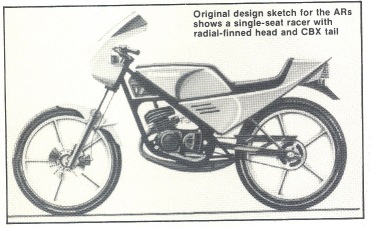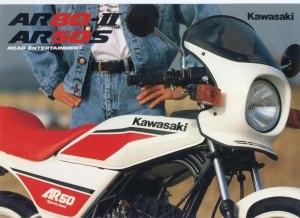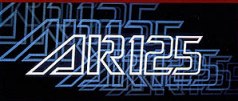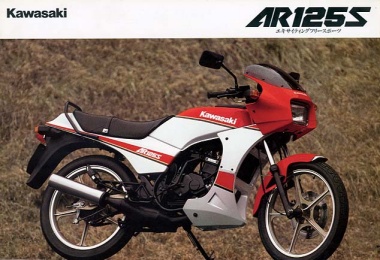
Street debut in style!
We have made this model overview for you of the Kawasaki AR and the affiliated models such as the AE50 and 80 and the Micro Magnum and Ninja80 . With it you can determine wich model you have, comparing your framenumber with our database. You can find your framenumber at the right-front of your frame, where the electrical cables are. If you have questions about this or other items , do not hesitate to email us at technical @ ar50.info
The first concept of the AR50, wich shows a single seat racer with radial finned head and CBX tail.

"Big Bike fixtures"
"Kawasaki have decided to knock Honda off the number one spot. Nobody doubts their ability to build big, beefy performance bikes but can they hope to succeed in the fickle mass market for tiddlers?"
So began the review of the 'new' Kawasaki models AR and AE in 1981. The answer to the above question is easy now. They did succeed. Building a motorcycle that lasts for years and years.
"The customers they want are learners between 16 and 18 years old who buy for technical innovation and big bike styling as much as performance and costs. There are two engine sizes: 49 and 78cc. The fifties are 30mph restricted (UK). Both sizes are available in AR roadrace styling (A-Roadrace) or as enduro styled AE (A-Enduro) trail bikes"
"The frame is a full cradle , so there is no weedy-looking empty space under the steering head But the biggest feature of the rear end, indeed the biggest feature of the AR and AE range is that we have the first Kawasaki road bike with UNI-TRAK suspension"
The first Kawasaki AR models are the A-types. They have a totally different tail . Parallel to the A-range Kawasaki produced the AE50 models, wich were more different from the AR50 C models than the A models are.
Kawasaki AE50
The AE50 models actually are the offroad version of the AR50A wich are produced in the early 80's
Kawasaki started the production of the AR50 models in 1981 , and finished it for most markets in 1996 with the AR50-C10 , available in 2 colours Sunbeam Red and Ebony.
The AR50 catalogue price in 1996 was about € 2000,00 in the Netherlands an Belgium
The AR affiliated models are still available in Asian countries, where they are available under another name: Ninja80 or Micro Magnum and the latest model: ARmicro.
Actually Kawasaki never should stop producing this model, but that's our opinon.
The models were available in many different countries , Japan, the USA, The Netherlands, United Kingdom, Greece, Belgium, South Africa, Germany etc.
There were also special versions of the AR models, the AR50S and the AR80-II ,

For those who want that little bit more, Kawasaki produced the Kawasaki AR80 and the Kawasaki AR125
From the Kawasaki AR50, Aoshima made a 1:12 scale model , the first version was a Firecracker red A2, the second a lime green A2. Both with cowling / windscreen
More information on these models can be found in the section 'documentation'
The Dry weight of the AR50/80 models is about 78 kg . The AR50 has a 2-stroke engine with a 49cc displacement. Bore x Stroke is 39x41,6 mm and it has a 6-speed transmission (5 speed in the UK) The AR models have an Electronic CD Ignition (CDI) and a fuel capacity of 9,6 Litres. The maximum power (UK market) for the AR50 is 2,1 kW at 4.500 rpm and a maximum torque at 4,5 Nm at 4.000 rpm.
The AR80 has also a 2 stroke engine, but a displacement of 78 cc. The maximum power (UK) is 7,5 kW at 8.500 rpm. The maximum Torque is 8,53 Nm at 8000 rpm.
With an automatic superlube oil injection, the AR models ensure maximum convenience and reliability.
The handlebars of the AR50 and AR80 are separate, so they provide a comfortable low-profile riding position. The proven reed-valve two stroke Single delivers the kind of power that's made Kawasaki famous.
Street Entertainer
The Kawasaki AR125 has an RRIS system: a reed valve and a rotary disk-valve precisely control intake timing to stretch the powerband.
It also has a hot-firing CD ignition but a liquid cooling system.
It has a displcement of 123cc and a Borexstroke of 55x51,8 mm As the AR50 and AR80 it has a 6-speed transmission and a front-disk and rear-drum brake.
The dry weight of the AR125 is 107 kilograms and it had a fuel capacity of 11,5 litres.
All models have Kawasaki's UNI TRAK rear suspension.

As the AR50 range , as told, the AR80 and AR125 had their specials too.



source


